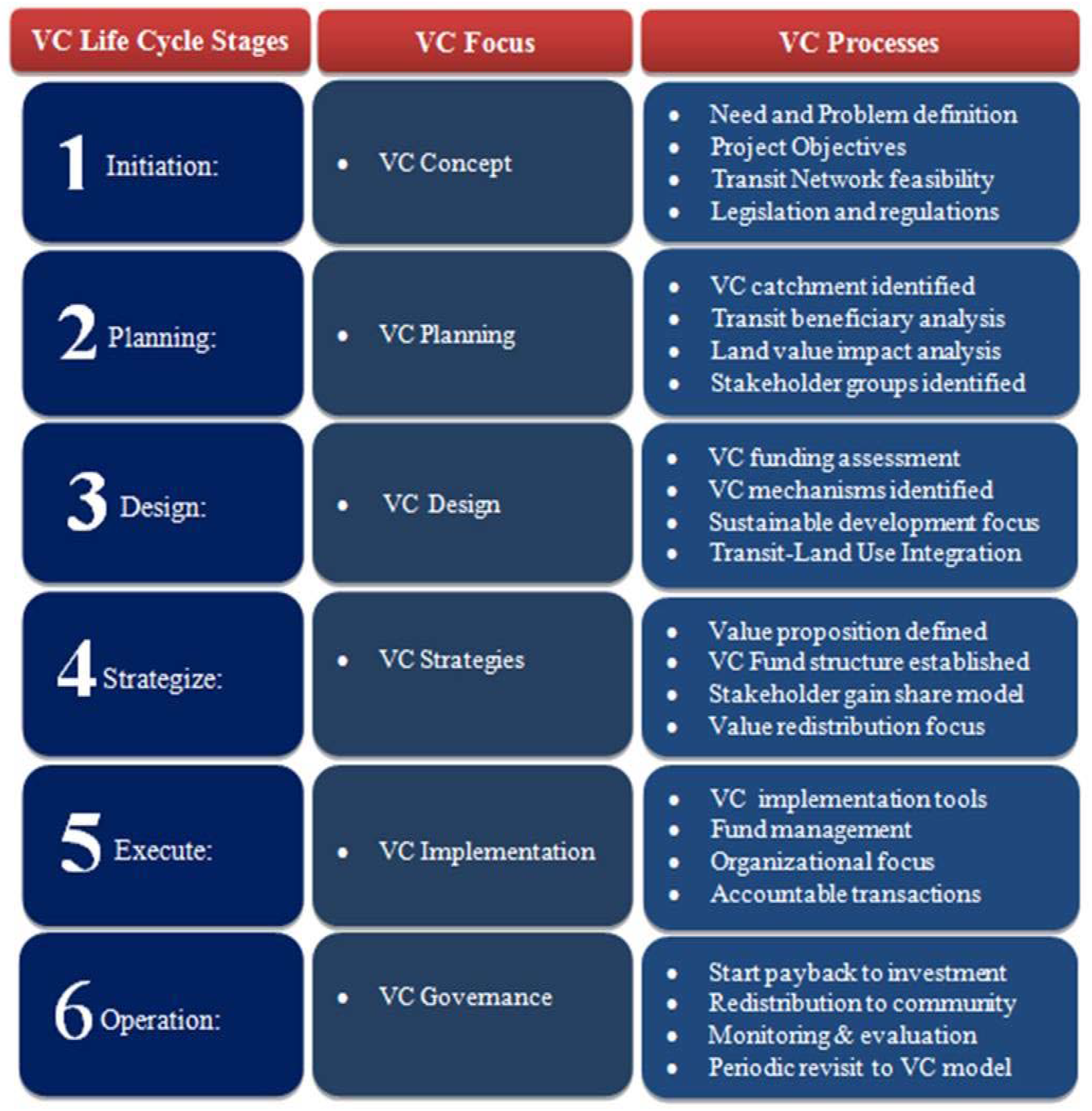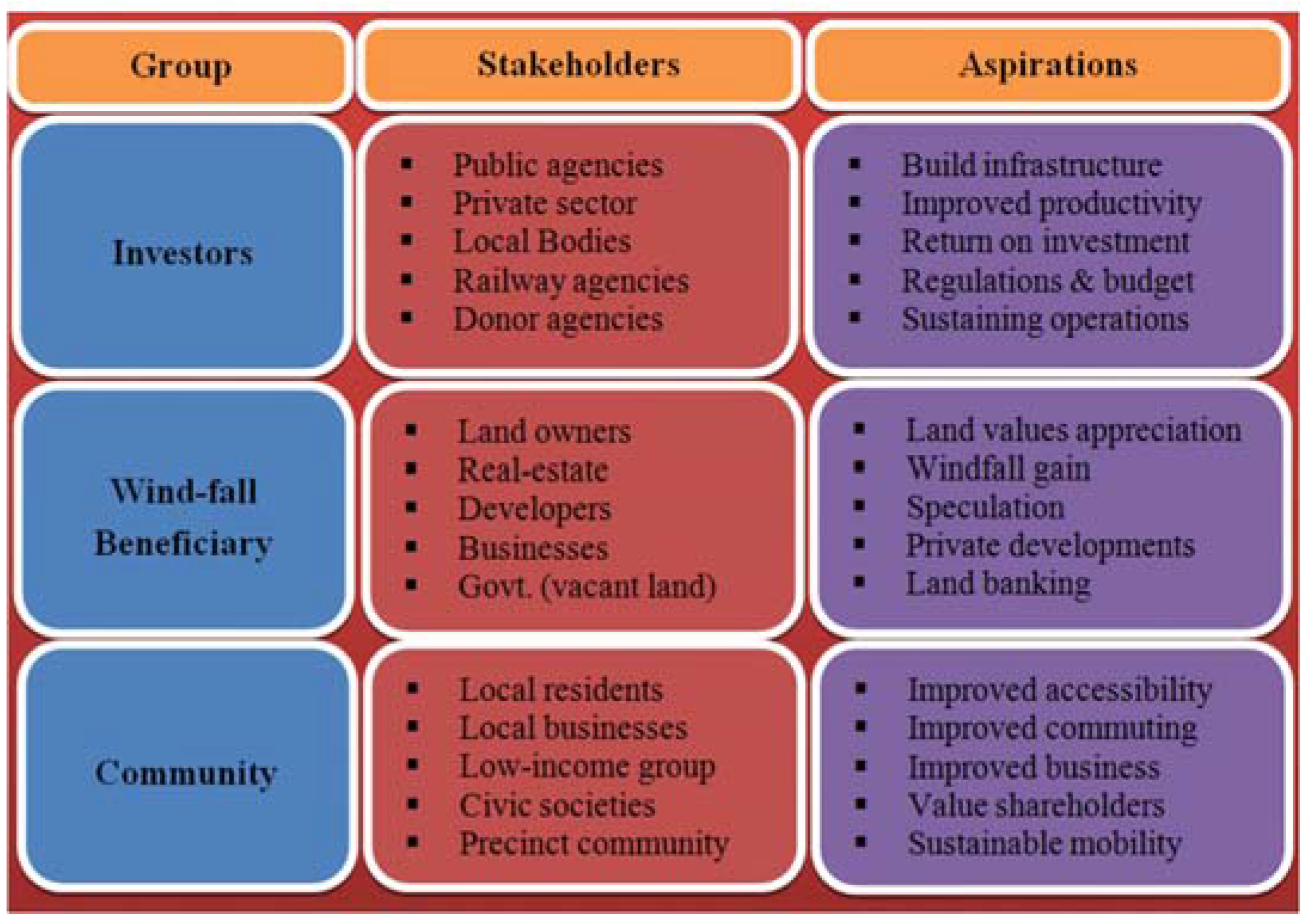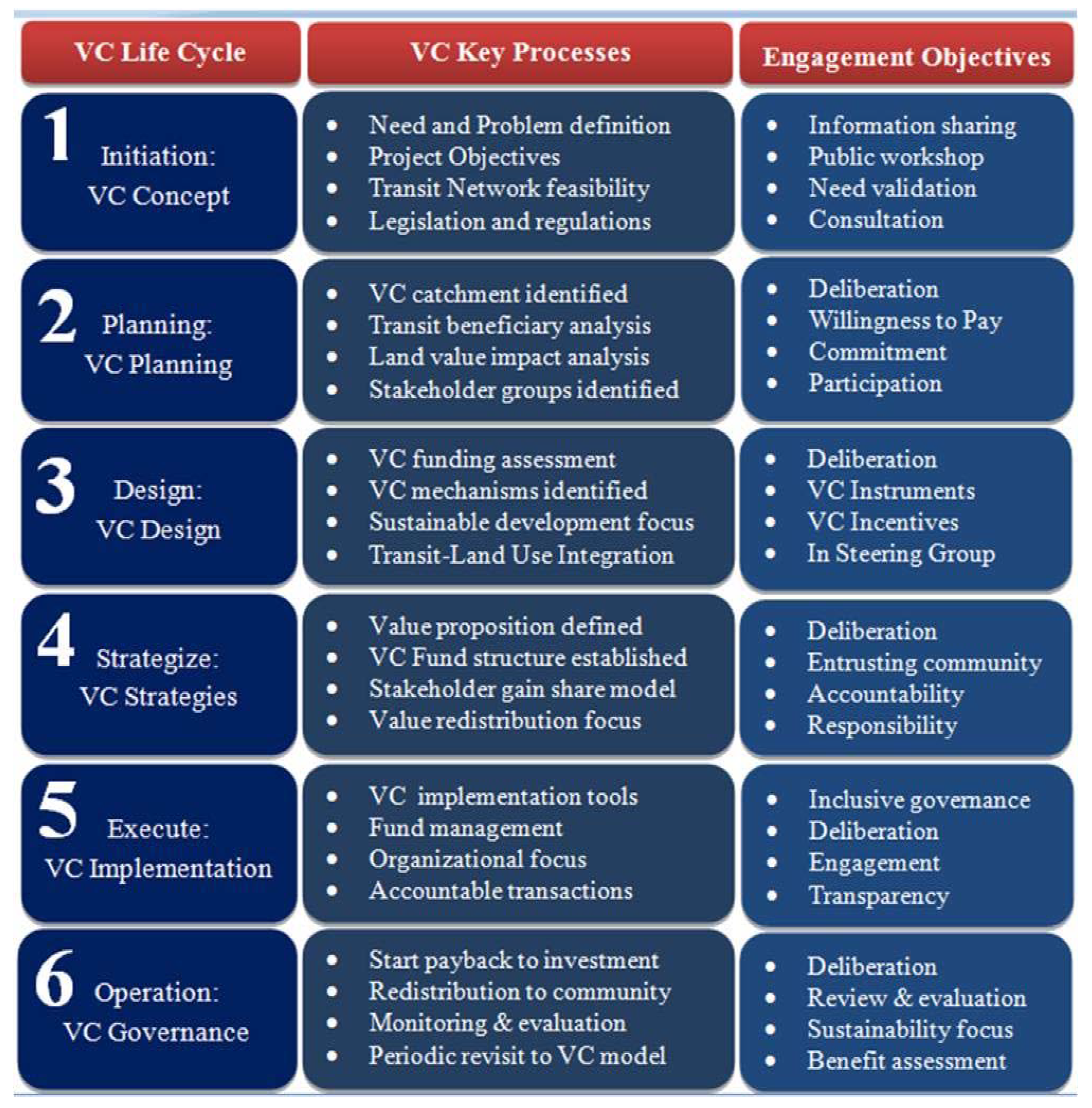Participatory Sustainability Approach to Value Capture-Based Urban Rail Financing in India through Deliberated Stakeholder Engagement
Abstract
:1. Introduction
2. Background to Participatory Sustainability Approach in a VC Context
2.1. Need for Participatory Stakeholder Engagement in a VC Context
2.2. Role and Techniques for Deliberated Participatory Stakeholder Engagement in a VC Context
- (1).
- Consensus Forum: This is a popular deliberation process in aiding shared understanding and meeting consensus in a complex and difficult decision making situation, where a variety of stakeholders namely, public, private, resident community, and civic societies are involved in decision making. This technique is particularly useful when the participants are greater in number and representing divergent views on more intricate issues, or most argumentative issues as the approach aids the consensus-based decision-making process.
- (2).
- Multi-Criteria Analysis (MCA): The MCA technique is a structured iteration-based deliberation technique, leveraging scientific data and technology to help the decision-making process. This technique is a means of simplifying complex decision-making tasks, which may involve many stakeholders, a diversity of possible outcomes, and many, and sometimes intangible, criteria by which to assess the outcomes. This tool would help to prioritize a set of options identified with appropriate weightages assigned, and rank them based on the pre-set deliberation objective.
- (3).
- World Café: This technique offers a simple, effective, and flexible format for hosting large group dialogue using participatory rounds of shared interactions especially in joint visioning, planning, and designing context, to motivate networked exchanges in smaller group rounds. In this approach, participation is only by invitation, based on the purpose of the meeting. World cafés can be used across a specific issue or multiple issues, where people engage in progressive rounds of conversations ascertaining questions related to a particular issue in each cluster.
- (4).
- 21st Century Town Meeting/Dialogue: This technique is a software enhanced public deliberation forum with near real-time outputs and priorities generated. This technique is more useful to conduct with a large group deliberation, and provides instant feedback. Participants are linked through online networked computers, and engage in informed deliberation in smaller groups through real-time feedback and deliberation to find common themes and priorities on most contentious issues. This primarily seeks substantive feedback on key issues, finding common ground, and to prioritize what is most important toward influencing decision-making.
- (5).
- Open Space Technology: The Open Space Technology meeting is to create time and space for people to engage deeply and creatively around issues of concern to them. Later, an open circle meeting is reconvened, where all participants can give their comments as part of a facilitated process. This is followed with a final plenary session where participants can give comments and, finally, it provides the outcome with a common understanding on defined goals, actions, milestones, and responsibilities with a way forward.
- (6).
- Local Area Forum: This technique is popular to bring together government, industry, and community to determine the optimal use of scant resources through coordinated actions and joint collaboration. It is more representative of the local community and can get greater local ownership of issues. In this method, local community is more involved and empowered to make informed decisions on what the community requires.
- (7).
- Strategic Questioning: This is a powerful problem-solving technique to engage groups in innovative thinking, to develop strategy, to facilitate change, and to gain acceptance to new ideas. Strategic questioning as a tool helps to find creative ways in times of uncertainty, conflict and confusion, and in case of current thinking, appears to be constrained.
2.3. Review of Best Practices for Participatory Stakeholder Engagement in a VC Context
2.4. Need for a Participatory VC Stakeholder Engagement Framework for Cities in Developing Countries
3. VC Process Life Cycle

4. Participatory Strategic Value Capture (PSVC) Framework
- Broad based community participation is enabled
- Effective communication and commitment is created
- Concurrence on shared goals, value created or expected
- Strategic, independent, adaptive and transparent approaches are developed
- Building trust among stakeholders through being inclusive
- Unbiased engagement objectives and plans are set upfront
- Equity in value redistribution is given due importance
- Sustainability goals are incorporated along with transit goals
- Transit station neighborhood aspirations are aligned with the project
- Conflict management processes are set up
- Stakeholder capacities are strengthened to enable adequate engagement
- Compliance with the city priorities, policy framework and legislation is enabled
- Step 1:
- Identify Stakeholders
- Step 2:
- Set Engagement Objectives
- Step 3:
- Select Engagement Techniques
- Step 4:
- Monitor Engagement Performance
4.1. Step 1: Identify Stakeholders

4.2. Step 2: Set Engagement Objectives

4.3. Step 3: Select Engagement Techniques

4.4. Step 4: Monitor Engagement Performance

5. PSVC Framework Applied to the Proposed Bangalore Suburban Rail Project
5.1. Step 1: Stakeholder Identification
5.2. Step 2: Set Engagement Objectives
5.3. Step 3: Select Engagement Techniques

5.4. Step 4: Monitor Engagement Performance
5.5. Discussion
6. Conclusions
Acknowledgments
Author Contributions
Conflicts of Interest
References
- Newman, P.; Kenworthy, J. Sustainability and Cities Overcoming Automobile Dependence, 1st ed.; Island Press: Washington, DC, USA, 1999; pp. 116–118. [Google Scholar]
- Newman, P.; Glazebrook, G.; Kenworthy, J. Peak Car Use and the Rise of Global Rail: Why this is happening and what it means for large and small cities. JTTs 2013, 3, 272–287. [Google Scholar] [CrossRef]
- Cervero, R.; Duncan, M. Rail’s Added Value. Urban Land. 2002, 6, 77–84. [Google Scholar]
- Cervero, R. Rail Transit and Joint Development: Land Market Impacts in Washington, DC and Atlanta. J. Am. Plann. Assoc. 1994, 60, 83–94. [Google Scholar] [CrossRef]
- Smith, J.J.; Gihring, T.A. Financing Transit Systems through Value Capture: An Annotated Bibliography. Am. J. Ecol. Sociol. 2006, 65, 751–786. [Google Scholar] [CrossRef]
- William, B.H. Value Capture as a Policy Tool in Transportation Economics: An Exploration in Public Finance in the Tradition of Henry George. Am. J. Econ. Sociol. 2001, 60, 195–228. [Google Scholar]
- Medda, F.R. Land value capture finance for transport accessibility: A review. J Transp. Geogr. 2012, 25, 154–161. [Google Scholar] [CrossRef]
- Smolka, M.O. Implementing Value Capture in Latin America: Policies and Tools for Urban Development, a Policy Focus Report; The Lincoln Institute of Land Policy: Cambridge, MA, USA, 2013. [Google Scholar]
- Wolf-Powers, L. Community Benefits Agreements in a Value Capture Contex. In Value Capture and Land Policies; Ingram, G.K., Hong, Y., Eds.; Lincoln Institute of Land Policy: Cambridge, MA, USA, 2012; pp. 217–232. [Google Scholar]
- Gross, J. CBAs: Definitions, values, and legal enforceability. Int. J. Afford. Hous. Comm. Dev. Law. 2008, 17, 36–58. [Google Scholar]
- Walker, J. Land Value Capture and Infrastructure Delivery through SLICs. In T&CP Tomorrow Series Paper 13; TCPA: London, UK, 2012. [Google Scholar]
- Smolka, M.O. A New Look at Value Capture in Latin America. J. Land Lines 2012, 243, 10–15. [Google Scholar]
- Jillella, S.S.K. Unlocking land values in financing urban infrastructure. In CiSTUP News Letter, Volume 3; Indian Institute of Science: Bangalore, India, 2012; pp. 14–15. [Google Scholar]
- Smolka, M.O.; Iracheta, A. Mobilizing Land Value Increments to Provide Serviced Land for the Poor; Lincoln Institute of Land Policy: Cambridge, MA, USA, 1999. [Google Scholar]
- Scheurer, J.; Newman, P.; Kenworthy, J.; Gallagher, T. Can Rail Pay? Light Rail Transit and Urban Redevelopment with Value Capture Funding and Joint Development Mechanisms; Institute for Science and Technology Policy: Murdoch University, Perth, Australia, 2000. [Google Scholar]
- OECD. Citizens as Partners: OECD Handbook on Information, Consultation and Public Participation in Policymaking; Organization for Economic Cooperation and Development (OECD): Paris, France, 2001. Available online: http://internationalbudget.org/wp-content/uploads/Citizens-as-Partners-OECD-Handbook.pdf (accessed on 8 September 2014).
- Holmes, B. Citizens’ Engagement in Policymaking and the Design of Public Services; Australian Parliamentary Library: Canberra, Australia, 2011. [Google Scholar]
- OECD. Promise and Problems of E-Democracy; Organization for Economic Cooperation and Development (OECD): Paris, France, 2003. Available online: http://www.oecd.org/governance/public-innovation/35176328.pdf (accessed on 10 September 2014).
- OECD. Focus on Citizens: Public Engagement for Better Policy and Services. 2009. Available online: http://www.oecd.org/dataoecd/20/3/42658029.pdf (accessed on 8 January 2015).
- Ramanathan, R. A note on the use of the analytic hierarchy process for environmental impact assessment. J. Environ. Manag. 2001, 63, 27–35. [Google Scholar]
- Kenneth, M.A.; Andrew, C. Stakeholder engagement: A mechanism for sustainable aviation. Corp. Soc. Responsib. Environ. Manag. 2006, 13, 245–260. [Google Scholar]
- Bolton Council. Involving Our Communities: Bolton’s Community Engagement and Tool Kit. 2007. Available online: http://www.bolton.gov.uk/sites/DocumentCentre/Documents/CommunityEngagementAndConsultationToolkit.doc (accessed on 10 May 2015). [Google Scholar]
- Hartz-Karp, J. How and why deliberative democracy enables co-intelligence and brings wisdom to governance. J. Public Deliber. 2007, 3, 1–9. [Google Scholar]
- Carolyn, J.L.; Lars, H.T. Public Deliberation: A Manager’s Guide to Citizen Engagement. IBM Center for the Business of Government, 2006. Available online: http://www.businessofgovernment.org/report/public-deliberation-managers-guide-citizen-engagement (accessed on 20 June 2015).
- Hartz-Karp, J. Deliberative Democracy: Techniques that Create Opportunities for Joint Decision-making. In Participatory Sustainability (302475) Unit Information and Learning Guide; Curtin University of Technology: Perth, Australia, 2013; pp. 45–119. [Google Scholar]
- Margaret, G.; Hartz-Karp, J. The Role of Deliberative Collaborative Governance in Achieving Sustainable Cities. J. Sustain. 2013, 5, 2343–2366. [Google Scholar]
- Musil, T.A. The sleeping giant: Community benefit agreements and urban development. J. Urban Law. 2012, 44, pp. 827–852. Available online: http://ir.stthomas.edu/ocbfincpub/18 (accessed on 20 April 2015).
- Wolf-Powers, L. Community Benefits Agreements and Local Government: A review of recent evidence. J. Am. Plan. Assoc. 2010, 762, 141–159. [Google Scholar] [CrossRef]
- Been, V. Community benefits agreements: A new local government tool or another variation on the exactions theme? Univ. Chicago Law Rev. 2010, 771, 5–35. [Google Scholar]
- Christopher, D.H.; Mark, R.F. The North American Light Rail Experiences: Insights for Hamilton; McMaster University: Hamilton, ON, Canada, 2012. Available online: http://mitl.mcmaster.ca/documents/MITL_LRT_August.pdf (accessed on 20 June 2015).
- Mathur, S.; Smith, A. A Decision-support Framework for Using Value Capture to Fund Public Transit: Lessons from Project-specific Analyses. 2012. Available online: http://transweb.sjsu.edu/PDFs/research/1004-decision-support-framework-value-capture-public-transit-funding.pdf (accessed on 2 May 2015).
- David, M. Portland streetcar brings economic development. 2014. Available online: http://www.cincinnati.com/story/opinion/contributors/2014/03/26/portland-cincinnati-streetcar-david-mann/6930051/ (accessed on 20 May 2015).
- Paul, K.S. Financing the Airport Light Rail Line in Portland, Oregon: A Case study of public-private partnership. J. Struct. Financ. 2001, 7, 54–67. [Google Scholar]
- Oregon Metro. Public Engagement Guide: Final Adoption Draft. 2013. Available online: http://www.oregonmetro.gov/sites/default/files/final_draft_public_engagement_guide_112113.pdf (accessed on 8 May 2015). [Google Scholar]
- Ministry of Urban Development; National Urban Transport Policy (NUTP); Government of India. National Urban Transport Policy. 2006. Available online: http://moud.gov.in/sites/upload_files/moud/files/pdf/TransportPolicy.pdf (accessed on 20 June 2015). [Google Scholar]
- Cervero, R. Linking Urban Transport and Land use in Developing Countries. J. Trans. Land. 2013, 6, 7–24. [Google Scholar] [CrossRef]
- Suzuki, H.; Luchi, K.; Cervero, R. Transforming Cities with Transit: Transit and Land-Use Integration for Sustainable Urban Development; The World Bank: Washington, DC, USA, 2013. [Google Scholar]
- McIntosh, J.; Newman, P.; Crane, T.; Mouritz, M. Alternative Funding Mechanisms for Public Transport in Perth: The Potential Role of Value Capture, Discussion Paper; Curtin University Sustainability Policy Institute: Perth, Australia, 2011. [Google Scholar]
- Larson, S.; Williams, L.J. Monitoring the Success of Stakeholder Management: Literature Review. In People, Communities, and Economies of the Lake Eyre Basin; Mesham, T.G., Ed.; Alice Springs: Canberra, Australia, 2009; pp. 251–298. [Google Scholar]
- Newman, P.; Matan, A. Report on Stemming Car Dependency and Improving Transport Options in Indian Cities; Technical report of AusAID Public Sector Linkage Program Project (65080); Curtin University Sustainable Policy (CUSP) Institute: Perth, Australia, 2013. [Google Scholar]
© 2015 by the authors; licensee MDPI, Basel, Switzerland. This article is an open access article distributed under the terms and conditions of the Creative Commons Attribution license (http://creativecommons.org/licenses/by/4.0/).
Share and Cite
Jillella, S.S.K.; Matan, A.; Newman, P. Participatory Sustainability Approach to Value Capture-Based Urban Rail Financing in India through Deliberated Stakeholder Engagement. Sustainability 2015, 7, 8091-8115. https://doi.org/10.3390/su7078091
Jillella SSK, Matan A, Newman P. Participatory Sustainability Approach to Value Capture-Based Urban Rail Financing in India through Deliberated Stakeholder Engagement. Sustainability. 2015; 7(7):8091-8115. https://doi.org/10.3390/su7078091
Chicago/Turabian StyleJillella, Satya Sai Kumar, Annie Matan, and Peter Newman. 2015. "Participatory Sustainability Approach to Value Capture-Based Urban Rail Financing in India through Deliberated Stakeholder Engagement" Sustainability 7, no. 7: 8091-8115. https://doi.org/10.3390/su7078091
APA StyleJillella, S. S. K., Matan, A., & Newman, P. (2015). Participatory Sustainability Approach to Value Capture-Based Urban Rail Financing in India through Deliberated Stakeholder Engagement. Sustainability, 7(7), 8091-8115. https://doi.org/10.3390/su7078091






